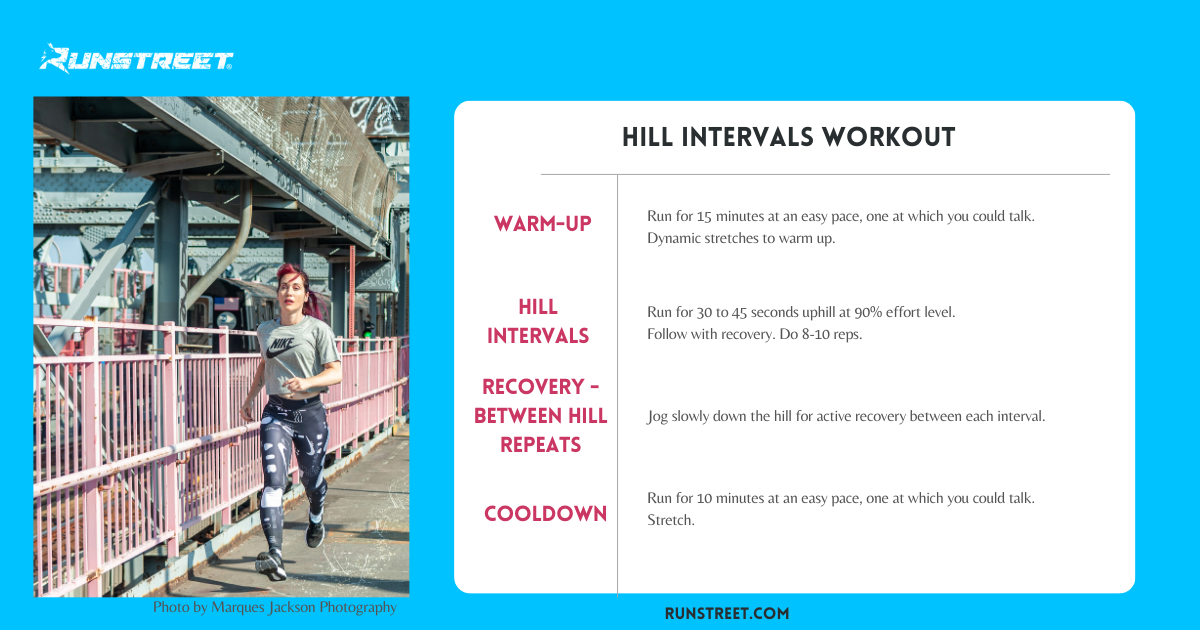Hill Workouts Guide + Sample Workouts
Become a Better Runner with Hill Workouts
Hill workouts offer many benefits. Photos by Marques Jackson Photography.
By Marnie Kunz,
Certified trainer and run coach
If you’re a runner, hill workouts may not be your fave, but they have so many benefits — from stronger legs to better running form and a faster race pace. Running hills even strengthens your core. Hill workouts are a great power-building workout. In this guide, I’ll break down the benefits of hill workouts as well as offer my tips as a running coach on how to do your own hill training. As with other forms of running workouts, hill workouts are hugely adaptable so you can structure them to suit your running goals and fitness level.
What Is A Hill Workout?
A hill workout is a run where you go up hills (or an incline on the treadmill) several times. Some hill training - such as hill sprints - require running fast at your max effort level and other hill workouts require a longer, slower ascent. Training on uphills can put less pressure on your joints than flat running and challenges your core and leg muscles more intensely.
Related Post: Guide to Running Downhill: Tips From a Run Coach
A hill workout may be as informal as running a loop on a hilly course. Hill training can also be planned intervals, with repeats of running up a hill for a measured time or distance. Between the repeats are recovery jogs or walks down the hill.
Whatever form of hill workout you choose, regular hill training will pay off with better running form and efficiency and a quicker running pace.
Related Post: 10 Running Drills to Become a Better Runner
Benefits of Hill Workouts
As I mentioned, hill workouts have so many benefits for runners. Running up hills helps build your leg strength, improves your running efficiency, expands your stride length, and improves your running speed. Hills are basically the superfood of running workouts, helping you to stay healthy and strong.
Here are some of the major benefits of hill training:
Improved leg strength. Hill reps strengthen your leg muscles, including your quads, and your glutes. Stronger legs mean higher speeds and less fatigue in races.
Adjust your stride when you're running up and down hills to avoid overstriding. Shortern your stride for steep inclines. For longer, gradual hills, you can keep your stride about the same as running on flat ground. Adjusting your stride for steep hills will have less impact on your joints and help you to balance.
Better running form and efficiency. Hill circuits will help you run with good form (on the hills and on flat terrain). Your mechanics will improve and you’ll expend less energy when you run.
You can adjust your workout to suit any level by increasing speed or repetitions. Marathon runners can do longer hill repeats, for instance, whereas 5K runners may do shorter intervals.
Overcome training plateaus. According to the American Council on Exercise, hill training helps you break through fitness plateaus.
In contrast with weightlifting, which is beneficial for building strength but isolates muscle groups, hill workouts build your muscle strength and power to work together as you run. When you do a hill workout, the muscles and tendons in your lower body — hips, glutes, legs, ankles, and feet — all have to work together to fight gravity and push you up the hill. The muscles need to contrast with greater force, making hills an excellent workout for building power.
Try this hill interval workout to become a better runner.
How to Do Hill Workouts
So with all the benefits of hill workouts, are you ready to go tackle a mountain now? (or ok, at least a hill). Here’s the rundown on how to do hill workouts, as well as a sample hill workout that you can try. A great thing about hill workouts is that you can adapt these to suit your fitness level and training goals, so you can add repeats for the hill intervals or add intensity by speeding up your pace.
As for the steepness, a 3 to 5 percent grade is enough for beginning hill workouts. As you become more experienced, you may want to increase the hill grade up to 7 percent or more for higher intensity hill sessions. If you're training for a race with gradual hills, doing long hill repeats can be helpful. For these, you will want to increase your time running on the hill to build your endurance.
Sample Hill Intervals Workout
You can do this hill intervals workout on a hill or incline such as a bridge (pictured). You want to find a hill that is long enough to run up for at least 30 seconds for this workout.
Here is a sample hill intervals workout:
Hill workouts can help you break through a fitness plateau.
Warm-up: Run for 15 minutes at an easy pace. This should feel comfortable. For beginning runners, you can adjust the warm-up run to 10 minutes. Do dynamic stretches after your warm-up.
Hill Intervals: Run for 30 seconds uphill at a fast pace, about 90% effort level. For runners training for longer distance races such as a marathon, you can increase the hill running duration to 45-second intervals. Beginners or those just getting back into running should start with 4 sets of 30-second hill intervals, with a slow recovery jog or walk down the hill between each interval. For more advanced runners or those training for longer distance races, build up to running 8 to 10 hill intervals.
Recovery: Jog or walk down the hill after each interval for active recovery. Go at a relaxed, easy pace. Going slow gives your body time to recover as well as reduces the impact on your joints of running downhill.
Cooldown: Run at a relaxed pace for 10 minutes. Stretch.
As with most running workouts, you can adapt the hill intervals workout to your training goals. So if this is your first hill workout, you will want to start with four 30-second hill intervals. For runners training for longer races, such as a marathon, build up to more hill repeats, 8 or 10. Also, if you are training for a long race and need to get more miles in your workout, you can add more running time to your warm-up and cooldown. If you are training for shorter races (such as the mile) or want to add more intensity to your hill workouts, run up the hill at a faster speed, at 95% effort level.
Hill Running Form
Hills are demanding, and tackling them requires an altered running form that is different than flat running. Here are some tips to keep your uphill running form strong:
Lean slightly forward running uphill. Many runners lean too far forward and hunch over, looking down. You want to have a slight lean while staying tall and upright with your shoulders back.
Keep your arms bent at about 90 degrees and rotating at the shoulder, swinging forward and back with no wasted side-to-side motion.
Focus ahead. Keep your head up and looking forward 10 to 20-feet ahead of you. Resist the urge to look down at the ground, which will slow you down and cause you to hunch over.
How Often To Do Hill Workouts
I recommend adding a hill workout to your running program once a week if you are in race training mode. If you are training for fitness or just getting into running, do a hill workout once every two weeks as you build up your base fitness level.
A hill workout is categorized as a “hard” training day so you should schedule an easy base run or rest day the next day. Following the easy-hard principle of training, you should also do an easy workout or have a rest day the day before your hill workout.
Hill Workout Recovery
To recover from your hill workouts, replenish with at least 16 ounces of water and electrolytes post-workout. Also, make sure you stretch after hill workouts. To speed up recovery for sore or tired legs, you can lie on your back and put your legs up a wall, so you are in a rotated seated position with your legs out straight up the wall, at a 90-degree angle to your body. Foam rolling is also a great way to help speed up your recovery from a tough hill workout.
Do you incorporate hills in your training program? Follow and tag @Runstreet on Instagram to share your training and get cheered on. If you need a customized running program including hill workouts, head to the Runstreet Training Center. We have different training plans for various race distances, from 5K training to marathon training.
Happy running to you!
Related Posts: Running Essentials: The Base Run, 5 Running Workouts to Get Faster
Marnie Kunz is a NASM-certified trainer and USATF- and RRCA-certified running coach, dog lover, Akita mom, and writer based in Brooklyn, NY. She is the founder of Runstreet.





